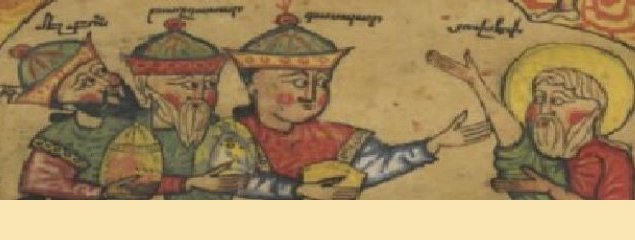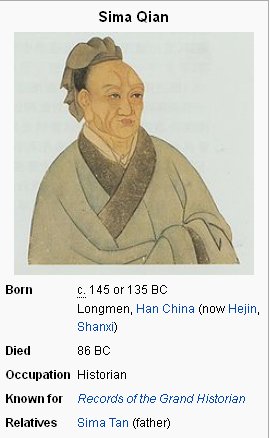[i] Eusebius, (ca. 263-ca. 339) author of the Chronicle translated below, was a major Christian author and cleric of the fourth century. His other writings, many of which have survived, include the Ecclesiastical History, the Life of Constantine, historical, martyrological, apologetic, dogmatic, exegetical, and miscellaneous works. Although originally written in Greek, his important Chronicle (Chronography, or Chronicon) has survived fully only in an Armenian translation of the 5th century, of which our present edition is a translation. A fifth century Latin translation (known as Jerome’s Chronicle) contains only the second part of Eusebius’ two-part work, namely the chronological tables which accompany the text of Book One. Nonetheless, the Latin translation of the chronological tables is invaluable, since the beginning and ending of the corresponding Armenian parts of Book Two are damaged. Reflecting 5th century Armenia’s multi-lingual cultural milieu, Eusebius’ Chronicle initially was translated into Armenian from the original Greek, then corrected using a Syriac edition. During the same period Eusebius’ other influential work, the Ecclesiastical History, was translated into Armenian from the Syriac. From almost the moment of their translation, Eusebius’ works played an important role in the development of Armenian historical writing.
Many of Eusebius’ extant Greek texts were written while the author worked at the library in Caesarea Palestina founded by the scholar Origen (ca. 185–ca. 254), where he had access to numerous works of antiquity which have not survived. Eusebius’ welcome technique of including sometimes lengthy passages from such lost works guaranteed his writings an important place in historical literature, quite apart from his impressive literary and analytical abilities. These general characteristics of Eusebius’ work are particularly highlighted in the Chronicle. The Chronicle was the ancient world’s first systematic, chronologically sound, universal history. It begins with the earliest extant written records available to our author and continues to his own day, that is to the year 325.
 Among the sources cited and often quoted from at length are Berosus, Alexander Polyhistor, Abydenus, Josephus, Castor, Diodorus, Cephalion, various named translations of the Bible, the writings of Manetho, Porphyrius, and others. In a brief introduction, Eusebius describes the plan of his work. He proposes to give a prose description of salient events and personalities from the civilizations of the Chaldeans, Assyrians, Medes, Lydians, Persians, Hebrews, Egyptians, and Greeks, plus listings of the Greek Olympiads, and the rulers of the Greek city-states, the Macedonians, and Romans. Continue reading Full Text of Eusebius’ Chronicle Chronicon Proving the Patriarchs & the Flood →
Among the sources cited and often quoted from at length are Berosus, Alexander Polyhistor, Abydenus, Josephus, Castor, Diodorus, Cephalion, various named translations of the Bible, the writings of Manetho, Porphyrius, and others. In a brief introduction, Eusebius describes the plan of his work. He proposes to give a prose description of salient events and personalities from the civilizations of the Chaldeans, Assyrians, Medes, Lydians, Persians, Hebrews, Egyptians, and Greeks, plus listings of the Greek Olympiads, and the rulers of the Greek city-states, the Macedonians, and Romans. Continue reading Full Text of Eusebius’ Chronicle Chronicon Proving the Patriarchs & the Flood →
 Dr. Ze’ev Herzog also a professor of Archaeology of Tel Aviv University stated that, “This is what archaeologists have learned from their excavations in the land of Israel: The Israelites were never in Egypt, did not conquer the land in a military campaign and did not pass it on to the 12 tribes of Israel.” BUT……
Dr. Ze’ev Herzog also a professor of Archaeology of Tel Aviv University stated that, “This is what archaeologists have learned from their excavations in the land of Israel: The Israelites were never in Egypt, did not conquer the land in a military campaign and did not pass it on to the 12 tribes of Israel.” BUT……

![Archaeologists Find Overwhelming Proofs that the Bible is Truly Historical [VDO]](https://ancientpatriarchs.files.wordpress.com/2017/06/janecahillbibleevidence.jpg?w=672&h=372&crop=1)

 Among the sources cited and often quoted from at length are Berosus, Alexander Polyhistor, Abydenus, Josephus, Castor, Diodorus, Cephalion, various named translations of the Bible, the writings of Manetho, Porphyrius, and others. In a brief introduction, Eusebius describes the plan of his work. He proposes to give a prose description of salient events and personalities from the civilizations of the Chaldeans, Assyrians, Medes, Lydians, Persians, Hebrews, Egyptians, and Greeks, plus listings of the Greek Olympiads, and the rulers of the Greek city-states, the Macedonians, and Romans.
Among the sources cited and often quoted from at length are Berosus, Alexander Polyhistor, Abydenus, Josephus, Castor, Diodorus, Cephalion, various named translations of the Bible, the writings of Manetho, Porphyrius, and others. In a brief introduction, Eusebius describes the plan of his work. He proposes to give a prose description of salient events and personalities from the civilizations of the Chaldeans, Assyrians, Medes, Lydians, Persians, Hebrews, Egyptians, and Greeks, plus listings of the Greek Olympiads, and the rulers of the Greek city-states, the Macedonians, and Romans. 
 By Brian Forbes
By Brian Forbes 



 After the universal deluge, the three sons of Noah, Shem, Ham and Japheth, fixed themselves for a period in the country about Mount Ararat, upon which, it will be recollected by all conversant with ancient tradition, that the ark of their highly favoured parent first settled on the subsiding of the waters. Here they multiplied considerably, and the anger of the Almighty against the sinful children of men, being appeased, fertility again covered the face of the earth, and peace and joy once more took possession of the bosoms of its inhabitants. Shem was the first to break the intimate union which subsisted between the families of his brethren and his own. Observing the rapidity with which the little community increased, he assembled his family, and communicating to the several members of it his intentions, he bade adieu to his brethren, and accompanied by his offspring, set out in a north-westerly direction, in search of a more commodious place of abode. In the course of a few days journey he arrived at the base of a lofty mountain, bounded by an extensive plain, and delightfully watered by a river, which passed through the middle of it. He rested two months on the banks of this river, and gave the neighbouring mountain the name of Shem, after himself. At the expiration of this period he resumed his journey, turning toward the south-east, leaving Taron, one of his younger sons, to settle in the country about the mountain to which he had given his name. The latter, on taking possession of his allotted inheritance, gave the land the name of Taron. It was subsequently called Taruberan. He then distributed to his several children portions of territory, all of which became, in course of time, populous provinces.
After the universal deluge, the three sons of Noah, Shem, Ham and Japheth, fixed themselves for a period in the country about Mount Ararat, upon which, it will be recollected by all conversant with ancient tradition, that the ark of their highly favoured parent first settled on the subsiding of the waters. Here they multiplied considerably, and the anger of the Almighty against the sinful children of men, being appeased, fertility again covered the face of the earth, and peace and joy once more took possession of the bosoms of its inhabitants. Shem was the first to break the intimate union which subsisted between the families of his brethren and his own. Observing the rapidity with which the little community increased, he assembled his family, and communicating to the several members of it his intentions, he bade adieu to his brethren, and accompanied by his offspring, set out in a north-westerly direction, in search of a more commodious place of abode. In the course of a few days journey he arrived at the base of a lofty mountain, bounded by an extensive plain, and delightfully watered by a river, which passed through the middle of it. He rested two months on the banks of this river, and gave the neighbouring mountain the name of Shem, after himself. At the expiration of this period he resumed his journey, turning toward the south-east, leaving Taron, one of his younger sons, to settle in the country about the mountain to which he had given his name. The latter, on taking possession of his allotted inheritance, gave the land the name of Taron. It was subsequently called Taruberan. He then distributed to his several children portions of territory, all of which became, in course of time, populous provinces. 
 Organicandhealthy,
Organicandhealthy, 
 Another part of the Shi Ji annals written by the Han historian Sima Qian a century before the time of Jesus. Shima Qian referred to ancient sources in his writings, that are not extant anymore. This chapter is about Yu the Great – Da Yu – whose father Gun failed to control the post Flood swelling lakes and rivers, and paid for it with his life! He was slain by ZhuRong
Another part of the Shi Ji annals written by the Han historian Sima Qian a century before the time of Jesus. Shima Qian referred to ancient sources in his writings, that are not extant anymore. This chapter is about Yu the Great – Da Yu – whose father Gun failed to control the post Flood swelling lakes and rivers, and paid for it with his life! He was slain by ZhuRong









